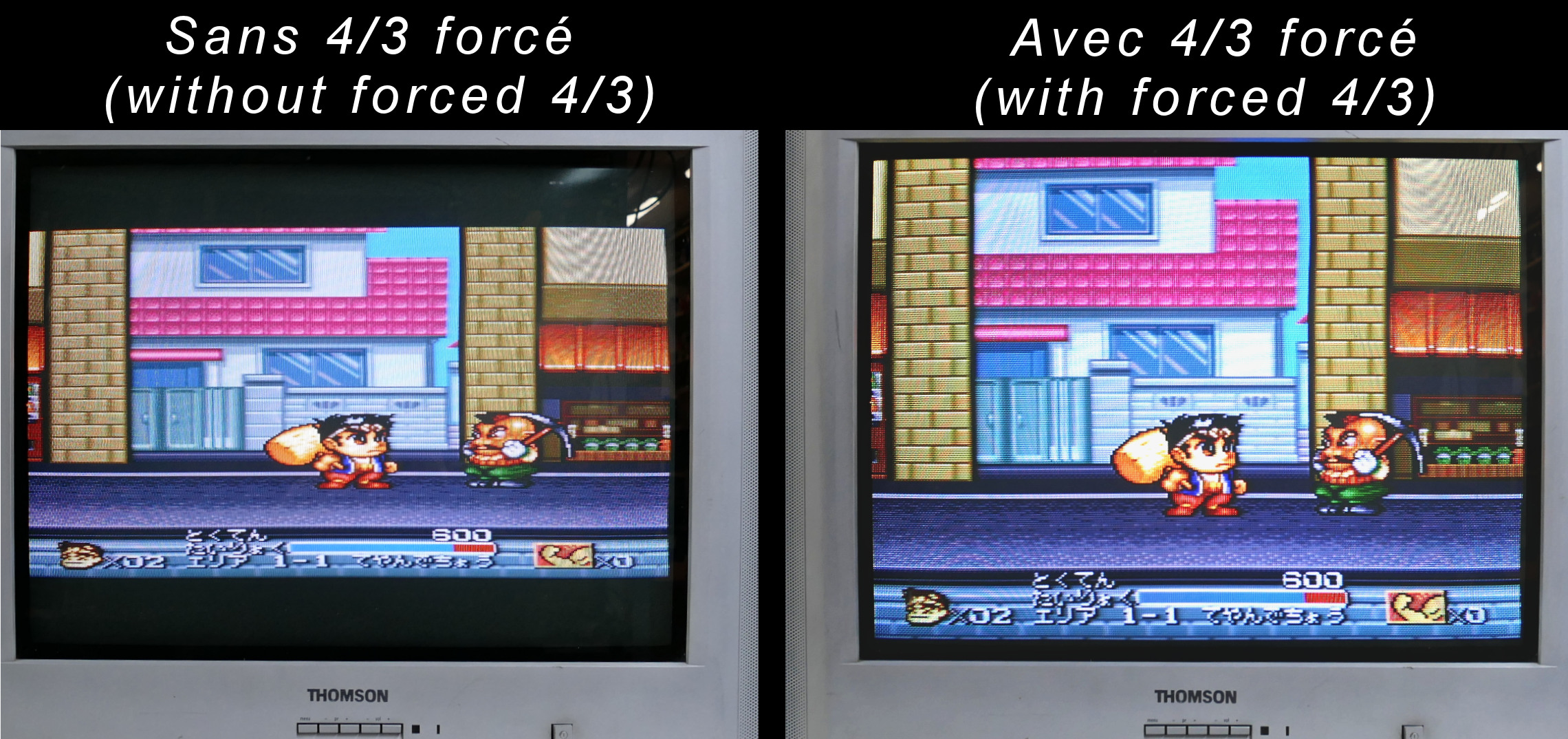Demystifying Video
Glossary / extension
This page aims to popularize some terms & concepts frequently used in the field of video and consoles. Video is a complex subject in reality. There are very good books to go further (for example: Video demystified at brooktree)
What is a video image?
We can imagine a grid made up of pixels. It is useful to visualize the pixel grid as a set of horizontal lines stacked on top of each other, this is how image information is processed. Each horizontal line, or scanline, is a row of stacked horizontal pixels. There are 625 lines in a PAL image (576 visible) and approximately 520 pixels per line. There are 525 lines in NTSC (480 visible) and approximately 440 pixels per line
What is resolution?
Resolution is the number of pixels that make an image. The higher it is, the sharper and more detailed the image will be. It is generally written [number of horizontal lines x number of pixels per line]
Example of resolutions:
Famicom: 256x240
PS1: 256 x 224 to 640 x 480 (variable resolution set by console depending on game)
What is PAL or NTSC?
These are video standards. There are 625 lines in a PAL image (576 visible) and approximately 520 pixels per line. There are 525 lines in NTSC (480 visible) and about 440 pixels per line
What is sync?
This is an essential process to ensure correct display between a source and a monitor (example: between a console and a TV). These are 2 signals, vertical sync (VSYNC) and horizontal sync (HSYNC). In the world of game consoles, the 2 vertical and horizontal components are often combined into a single signal called composite sync (CSYNC). It allows you to locate the start of display of an image, the start of horizontal lines, line returns, the displayed pixel, etc.
What is Csync?
It means composite sync (not to be confused with composite video)
It is the combination in a single signal of horizontal sync (HSYNC) + vertical sync (VSYNC)
What is a synchro cleaner/stripper?
We use this type of component to keep the CSync of the composite video signal. It "cleans" the composite video signal by removing the brightness and color components. All that remains is the Csync signal (HCYNC+ VSYNC]
What is native Csync?
It is the Csync signal that is generated by the console directly. It is sometimes accessible at the AV output level (Mega Drive, Japanese Saturn, some Neo Geo AES), or directly on the console's motherboard. The use of a synchro cleaner is useless in this case.
What is composite video signal?
It is also called CVBS (Color Video Blanking Synchro). This is a video format frequently used in electronics from the 90s-2000s, in particular game consoles, video recorders, dvd players, etc. It corresponds to the yellow RCA plug present on the cables of N64, PS1, etc. This signal was invented to simplify connections between devices, because in fact it is on a single video signal on which several information is combined: brightness + color + synchronization signals. This information can be coded in different ways, this is called standards: PAL/SECAM/NTSC. The quality of this signal remains generally quite poor
What is RGB
It is a color representation model in the video domain. Three primary components are needed Red, Green and Blue. These 3 signals are separated. This provides better quality compared to composite video. The 3 RGB signals alone are not enough to obtain an image, synchronization must be added. In the field of video games, this signal is independent, so we say that the format is RGBS. These signals are generally transfered through a SCART plug (or sometimes separately via BNC plugs)
To know: it is common for the composite video signal to be used as a synhro in RGB, because in fact it contains the synchronization information. This is the case for the Snes, the Saturn, the PS1…
It is preferable to use a synchro cleaner in order to improve the sharpness of the image on a CRT screen, reduce the effect of vertical bars, limit the ghosting effect on a flat screen (ghost outline), and limit saturation colours. The synchronization is then of the Csync type
What is a Scanline?
It is a horizontal scan line on a TV screen. It is a row of pixels forming a line of the image. On a cathode ray screen the horizontal scanning lines are visually discernible, even when viewed from a distance, as alternating colored lines and black lines, especially when the scanning system is interlaced.
A CRT TV screen?
It stands for Cathode Ray Tube Television. In retrogaming these screens are the most suitable for taking advantage of video resolutions and formats. There are different qualities, sony's trinitron are the reference, pro monitors are also very good for the rendering of scanlines (PVM, BVM, JVC...). These monitors are highly sought after and increasingly expensive...
What is frame rate?
This is the number of images displayed in one second.
An NTSC SNES displays 60 frames per second, a PAL console 50 frames per second. This information is often reported in 60Hz frequency form for SNES USA, and 50Hz for SNES PAL
What is progressive or interlaced display?
The interlaced mode separates the image into half images called frames (even and odd scanlines). When these frames are interlaced they create a solid image. This system called "interlacing" causes a slight flickering of the image and reduces its precision.
Progressive mode scans the full frame at once without interlacing. It increases the precision of the video. We obtain a more precise image but which causes slight jerks during rapid movements.
We use the fixed “p” (progressive) and the suffix i (interlaced) to specify the type of scan
Some game consoles like the Saturn can display interlaced or progressive video
What is 4/3 or 16/9 display?
4/3 is the ratio of the width of the visible image to the height of the visible image. Standard television has an aspect ratio of 4:3. Some TVs allow a 16/9 display. This notion is valid only in RGB. The composite video format is generally in 4/3.
The display setting is done via a direct voltage applied to pin 8 of the scart.
- Voltage of 5VDC = TV forcing in EXT mode & 16:9 display
- Voltage of 10-12VDC = TV forcing in EXT mode & displayed in 4/3
Most popular RGB cables do not respect this rule, they send 5V on pin 8 of the scart.
This is why we offer the forced 4/3 option with our RGB cables. This option is mainly useful with CRT cathode ray screens with display in 16/9th – 4/3 differentiated. In the absence of this option, the TV risks displaying an image in 16:9 by default, the image will then be overwritten (to be manually forced with the remote control in 4:3 each time).
95% of RGB cables on the market do not have them
Illustration in pictures: Super Famicom console + Daiku no Gen-san + RGB cable with and without the forced 4/3 option
This page is set to evolve, be improved, and corrected 😊
